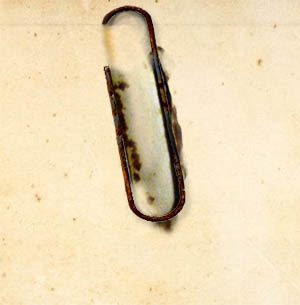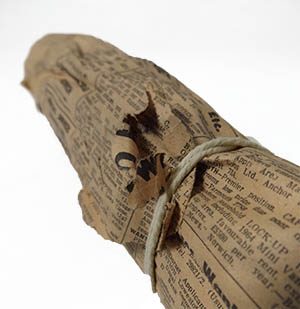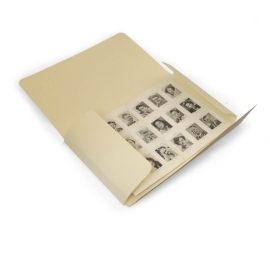A quick round-up on conservation fastenings...
Cue collective groan. Removing old fasteners is up there with pressure sensitive tape removal.  The fastening of papers presents an archivist or conservator with a number of issues.
The fastening of papers presents an archivist or conservator with a number of issues.
Paper clips
Paper clips present many issues, they are and have been an economic solution for fastening papers since the early 1900s. But that twisted piece of wire has caused many a conservation headache due to its prevalence.
Steel paperclips can rust, causing staining, and potentially acid migration leading to embrittlement in the paper they are holding. Removal of steel paperclips is essential for archival storage and conservation purposes.
Generally, paperclips are not the most conservation friendly form of fastening. They hold documents with tension over a small area which in itself can cause tears or creases. But, they are an economic way of keeping papers together.

So, can we use paperclips?
If you want to use paperclips, we recommend using our brass paperclips, stainless steel paperclips, or plastiklips which will not rust. Coupling them with a protective piece of folded acid free card, or polyester strip, reduces the risk of distortion in the paper.
Staples
As for paperclips, staples are a prevalent conservation nuisance. Unlike paperclips however, rusted steel staples can be somewhat more troublesome to remove, especially on fragile papers.
This page from the NEDCC provides some tips on how to remove rusted paperclips and staples using polyester, and a spatula.
Why are PEL staples OK to use?
Our Monel staples will not rust and are a good archival substitute if staples are required. Monel is a nickel/copper alloy and very resistant to corrosion, it’s used in marine and laboratory applications due to its high resistance to corrosion.
Treasury tags and straight pins
As with paperclips and staples, they can rust and cause irreparable damage to documents and textiles. Straight pins can be tricky to remove if the paper is fragile or if the pin is rusty. As with paperclips, removal of pins can be aided by placing a small piece of polyester between the paper and the pin preventing the rusty edge from causing damage on removal.
Rubber Bands
Rubber bands have long been used to bundle books and roll store papers due to their ease of use. Unfortunately, rubber can contain sulphur which, as the rubber degrades, can contribute to the creation of sulphuric acid. This causes serious structural damage to papers, textiles, leather.
The degradation of rubber can also leave residues on objects which can be difficult or impossible to remove. On top of all of this, the actual function the band was in-place to perform will have been negated by the its loss of elasticity. Cotton tying tape is the best archival substitution.
Please Note: Utmost care must be taken on removing old degraded rubber bands. The rubber may have adhered itself to the object’s surface which could lead to tearing on removal if not done with care.

Twine or string
Twine has been used to bundle books, secure roll stored papers and textiles, and other artefacts. Twine can cause issues when it’s used to tie objects as it can exert too much pressure on its narrow point of contact. Poor quality twine or string could also be abrasive which could cause cuts/tears, and may not be acid free.
When bundling items ensure that you use a good quality, soft, acid free twine, however it’s preferable to use a cotton tying tape which has a wider point of contact and therefore wider distribution of pressure.
We recommend using twine for tying identification tags and cotton tying tape for bundling and tying folders.
Cotton tying tape and Pink Legal Tape
Cotton tying tape is the most common tool for binding folders. Ensure it’s unbleached if using for archival storage.
It’s important that you use an archival quality pink legal tape to ensure that the dye doesn’t bleed and that the tape material is acid free. Ours is 100% cotton and the dye will not bleed.
Interestingly, pink legal tape began life as the much maligned ‘Red Tape’ with its use for binding legal files being the source of the oft used phrase for excessive regulation or rules. It’s understood it is still used in the legal profession today to provide visual reference between briefs.

The safest way to store documents is not to use any fastening directly in contact with the object, however budgets, storage space and time constraints don’t allow for the perfect world. Placing a small number of sheets in a designated folder with interleaving or polyester pockets for protection is the ideal, but this is usually reserved for more valuable or delicate objects.
It’s always best to consult a trained conservator for advice on how to store specific items. There may be cases where the fastening forms part of the object and therefore should also be conserved.
Our most popular folder is the Juris expansion folder which can accommodate papers up to 30mm in thickness. They are popular for a number of reasons; they are acid free and lignin free, buffered to control migrant acidity, available in the most common document sizes, and totally smooth. It’s important not to have any embossing which could over time leave an impression on the contents.